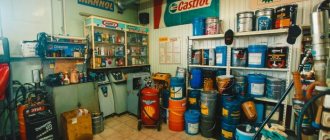Author of the article:
Muzyko Tatyana Andreevna - lawyer.
Fire extinguishers are a mandatory attribute of office premises, industrial buildings, crowded places, and cars.
Therefore, it is very important that it is in working condition at the right time.
Shelf life is one of the characteristics that will indicate the safety of properties.
What is regulated
The technical characteristics and shelf life of fire extinguishers are regulated by a number of standards:
Dear readers! To solve your problem right now, get a free consultation
— contact the lawyer on duty in the online chat on the right or call: +7 (499) 938 6124 — Moscow and region.
+7 (812) 425 6761 — St. Petersburg and region. 8 (800) 350 8362 - Other regions of the Russian Federation You will not need to waste your time and nerves
- an experienced lawyer will solve all your problems!
- SP 9.13130.2009 “Fire fighting equipment. Requirements for operation";
- NPB 166-97 “Fire fighting equipment. Requirements for operation";
- GOST R 51057-2001 “Fire fighting equipment. Fire extinguishers are portable. General technical requirements. Test methods";
- GOST R 51017-2009 “Fire fighting equipment. Mobile fire extinguishers. General technical requirements. Test methods";
- GOST 12.4.009-83 “System of occupational safety standards (SSBT). Fire fighting equipment for the protection of objects. Main types. Accommodation and service."
conclusions
Powder fire extinguishers have a long service life. Depending on the design and the OTV used, the operating period can be from five to ten years.
Due to the specific parameters of the powder (hygroscopicity, likelihood of clumping), additional control is required for OP - selective annual control for enterprises and once every 2 years for cars.
In case of damage to the housing, locking and starting mechanism, deviations in the pressure gauge reading, or the end of its service life, the fire extinguisher is sent for recharging or disposal to a licensed fire service.
If, during an inspection by authorized bodies, violations of the OP’s service are revealed, the inspector may impose a penalty in the form of a fine.
Timing and types
| Type | Carbon dioxide | Powder | Air foam | Water |
| Weight/volume/expiration date | ||||
| Automotive | 0,9-1,8/1-2/10 | 0,9-1,8/1-2/10 | — | — |
| Portable | 2-8/3,5-12/10 | 2-8/3,5-12/10 | 6-35/4-30/5 | 14-50/8-30/1 |
| Mobile | up to 90/up to 100/10 | up to 90/up to 100/10 | 70/40/5 | 70/40/1 |
The period of operation of fire extinguishers is determined by the manufacturer on the basis of regulatory documents. It is indicated in the passport (on the label) of the device, like other technical characteristics.
IMPORTANT! The shelf life of portable, mobile fire extinguishers in a metal case is about 10 years. For disposable products, the period is determined by the manufacturer.
Carbon dioxide
Requires annual inspection by an accredited facility, CO2 recharge every 5 years or after use. For OS used in transport, this period is reduced to 2 years. With proper maintenance and storage it will last 10 years. Various sizes are possible, up to industrial sizes: OU-55.
It is used in urban transport and trains.
Powder
A device in which powder acts as a fire extinguishing agent is a commonly used type. OP-2, OP-3 are used for cars and trucks, OP-4, 8 - at industrial enterprises. The service life if properly stored is 10 years. Requires recharging and maintenance:
- once every 5 years – when used indoors;
- once every 2 years - to protect vehicles.
The most versatile, suitable for extinguishing any fire.
Air foam
ORP is most susceptible to deterioration and can only last the required 5 years due to the activity of the aqueous charge solution, which leads to corrosion. May consist of water and alkali or foaming agent and water. Prohibited for use on electrical installations.
Used to eliminate small fires of solids and liquids.
Water
Fire extinguishing agents act on the flame using water. They have the shortest shelf life: after a year they require recharging.
Types of fire extinguishers and their service life
The period of use is affected by the following parameters:
- types of OTV:
- powder;
carbon dioxide, freon;
- water;
- foam (air, chemical);
- emulsion;
- aerosol composition;
- filling technology:
- downloads;
with a separate source of cold (displacement) gas;
- dimensions:
- mobile;
manual (portable).
Variants of the fire extinguishing agent have different corrosive effects on the cylinder, as well as the suitability of the mixture ingredients themselves. The method of generating pressure and containing the charge inside the container is important: pump fire extinguishers have higher pressure, and accordingly, the load on the body is greater, which entails the need for frequent maintenance.
Carbon dioxide
The OS is subject to mandatory recharging every 5 years. For automobile samples, the period is reduced to 2 years. The housing can be refilled an unlimited number of times, but its maximum resource is 10 - 15 years.
Powder
According to the OP, it should be taken into account that the assigned service life for different powder mixtures may differ. The powder often becomes unusable, as it is prone to clumping and caking. Standard for OP:
| Options | Period (years) |
| Standard | 5 |
| For transport | 2 |
| Frame | From 10 or more, if tests found it to be operational |
Emulsion
OVE are the most expensive fire extinguishers in existence. The lack of cost is compensated by high efficiency (5-7 l of ORP is equal to 100 l of ORP). Refilling is required once every 10 years, the duration of preservation of the properties of the OTV and the service life of the container itself is similar (or more according to test results).
Freon
OX is a type of gas primary fire extinguishing agent. The time frame for freon fire extinguishers is the same as for the OS, unless otherwise specified by the manufacturer, since some freons may have an increased corrosive effect.
The duration of the charge efficiency is more than 5 years in fact, but this does not matter since the gas is renewed after the specified period has expired.
Foam ORP and OCP
ORP and OHP are recharged once a year - this is the time to preserve the properties of the OTV. The cylinder is used for 5 years, since the charge is highly corrosive (water, alkaline, fluorine compounds, surfactants).
Water
For fire extinguishers, the rules are similar to those for foam fire extinguishers: 12 months. for the extinguishing agent and 5 years for the body.
Aerosol
Service life of aerosol fire extinguishing agents (years):
- 5 – ordinary;
- 2 – automobile.
Often the time frame for using aerosol-type fire extinguishers (marked GOA or AGS) is reduced to the first use, since many models are disposable.
Storage conditions
The rules for placing a specific fire extinguisher depend on several characteristics: its dimensions, contents, type of device.
IMPORTANT! The main requirement of the Ministry of Emergency Situations specialists is to use it for its intended purpose and comply with the control regime over the condition of the device with entry into a special log.
Business managers or individuals choose the location for storing fire extinguishers independently. It is important that they are not hidden and located close to the place where there is a maximum risk of fire (no further than 20 m from it in public buildings, 30–40 m in warehouses and industrial premises).
If there are several fire hazardous areas, they are equipped separately.
When choosing, you need to consider:
- The device must not be subject to mechanical damage.
- It should be kept away from exposure to high temperatures, sunlight, vibration and chemicals.
- Water tanks must be removed indoors when the temperature drops below 5 °C.
- Powder and carbon dioxide are kept at a temperature of -40...+50 °C.
- Humidity should be maintained at a normal level.
- Fire extinguishers should not impede the evacuation of people or block emergency exits.
- The fixation height depends on the weight of the device. If it is less than 15 kilograms, the top point cannot be higher than 1.5 m from the floor. For heavier specimens, a height of 1 m is provided.
These rules must be followed when storing any type of fire extinguishers. Their service life is shortened by direct sunlight, vibration and mechanical stress.
Is it possible to use expired
The use of expired devices is permitted only after a special check - a regeneration procedure. Without testing, operating a fire extinguisher whose useful life has not been extended is fraught with the following consequences:
- Danger to the lives of people in the room. At best, the device will not work at a critical moment. At worst, the cylinder will explode right in the hands of the person who pulled the trigger.
- Fines. If an expired device is found during an inspection at an enterprise, the organization faces a fine of 20,000 to 200,000 rubles.
- Damage to property. If the primary extinguishing means do not work, then people at the site are required to leave the premises and wait for the fire brigade to arrive. During this time, the flame intensifies, increasingly damaging the building and everything in it.
- Prohibition of activities. In the event of particularly large fire safety violations, the fire department suspends or prohibits the continuation of work in the building.
Attention! Using an expired device in a business or at home is unreasonably dangerous.
Marking
Each fire extinguisher has markings from which you can find out information about the device. The first letters characterize the composition of the stewing mixture:
- OV - aquatic;
- OVE - air emulsion with a fluorine-containing charge;
- ORP - air-foam;
- OP - powder;
- OC - carbon dioxide;
- OX - refrigerant.
The next number indicates the volume of the fire extinguishing agent (for example, OP-3 contains 3 liters of powder). The letters Z, B, G will tell you about the principle of creating pressure in the body.
Latin letters A, B, C, D, E indicate the fire class. After them is the model designation (01, 02). There is information about the manufacturer and operating pressure.
The label also provides brief instructions regarding recharging (immediately after use), inspection and testing intervals. Notes are made about each of the events.
Below is one of the main characteristics - the date of manufacture of the fire extinguisher and its expiration date.
Passport, markings and magazine
The results and information about the inspections are recorded in the fire extinguisher inspection log. It records identification data about the device, the dates of any manipulations provided for by the current rules, the brand of the charged fire extinguishing agent, information about the performer, the person in charge and their signatures.
An operational passport is issued for each fire extinguisher. Its first part indicates the registration and serial number of the fire extinguisher, the date of its manufacture and commissioning.
The following describes the installation location, brand and manufacturer. Be sure to indicate the type and brand of fire extinguishing agent. The placement location is usually marked on evacuation plans.
The passport must also contain a table with data on the implementation and results of maintenance, which is signed by the responsible person and secured with the seal of the enterprise, if any.
Most of them coincide with the list from the fire extinguisher logbook. However, in the passport you can see columns reserved for the weight and pressure of the fire extinguishing agent.
For a duplicate of the operational passport for the fire extinguisher, you must contact a specialized organization . Its employees conduct a check and draw up a new document. It is prohibited to use the device without a completed passport.
There must be a number on the body of the fire extinguisher, which is called serial or registration. It is applied using indelible paint. A label is attached to the case indicating information about the maintenance and condition of the device. The passport is kept by the official appointed responsible for fire safety by order of the enterprise.
How to determine
It is possible to independently determine the suitability of a fire extinguisher. First, look at the pressure gauge, the arrow should be in the green zone - this means that the cylinder is at pressure and can be used. In red, this is recharging, even if the service period has not expired.
A visual inspection reveals the integrity of the housing. It is also worth paying attention to the conditions under which the device is kept. If it is exposed to direct sunlight, the contents may have become unusable.
Then you need to inspect the markings. Date of manufacture (see factory sticker), 2 holes punched out (year and month). Depending on the content, the number of years that the device will last will vary from 1 to 10. The date of manufacture and permissible service life are marked. The remaining period is easy to calculate based on these values.
How to find the expiration date on a fire extinguisher
Question “How to determine the expiration date of a fire extinguisher?” has several answer options:
- The information is indicated in the device passport. The document indicates not only the date of manufacture, but also the standard period of operation.
- You can see the release date on the label affixed to the body of the fire extinguisher. Typically, two scales are drawn on the cylinder: with Roman (months) and Arabic (year) numerals. There are notches on each scale indicating the approximate production time.
Service life symbol on the fire extinguisher
Which one will fit in the car for technical inspection?
For people whose occupation is not related to fire safety, the most pressing issue is the availability of a fire extinguisher. Without it you will not be able to pass the inspection.
For car/truck/minibus
A powder or carbon dioxide fire extinguisher with 2-3 liters of active substance, OP-2, 3 or OU-1, 2, 3, is suitable for a car. The metal case is more reliable. For a cargo vehicle you will need a more significant volume - OU-5.
The powder one has excellent pressure, it is compact and inexpensive, the only drawback is that it leaves contamination.
Gas, on the contrary, evaporates, but is toxic. Therefore, it is recommended to use gloves when spraying.
ADVICE! When purchasing, be sure to pay attention to the integrity of the seal and the end of use.
Best before date:
- OP: 10 years for the cylinder, 2 for the powder;
- OU: 10 years per cylinder, 5 years per charge.
Where is the best place to store
The device must be carried in the car, fixed on a bracket. A good option is the passenger door. With this arrangement, the fire extinguisher will not interfere with the driver; at the right time it is easy to reach and use it.
Why can't it be placed in the trunk?
From experience, it can be said that access to the device in the luggage compartment can be difficult, although the rules do not regulate its location.
Indeed, it is not recommended to store fire extinguishing agents in the trunk. This is detrimental to any mixture. The device will have to be recharged annually to ensure the safety of passengers.
Is an expired vehicle eligible for technical inspection?
An expired fire extinguisher will not be suitable for technical inspection. It does not guarantee the safety of the car owner, which means it does not meet the requirements. Such rules exist to preserve the life and health of the driver and his passengers, so the owner must understand the importance of the current charge period.
What is the fine for an expired fire extinguisher?
Fines for violation of the NPB are provided for individual entrepreneurs, legal entities, including government agencies and public organizations. The GPS punishes the manager or person responsible for the facility. Fine amount:
- for individual entrepreneurs: 20,000 – 40,000 rubles;
- for legal entities persons: 150,000 – 200,000 rub.
Failure to correct the violation within 90 days. threatens to suspend the activities of the enterprise.
The traffic police inspector has the right to check the presence of a working fire extinguisher only when inspecting the car. The procedure is complex and is not used often (it requires good reasons). The fine will be 500 rubles. (Article 12.5 of the Administrative Code), but a citizen has the right to demand a warning. We must remember that it is impossible to complete the maintenance without a working fire extinguishing agent.
How long does it take to check?
Maintenance is carried out once a year at a station that has the appropriate license.
The fire extinguishing agent has a much shorter service life than the cylinder, so it must be changed in a timely manner. All models are recharged immediately after use or in case of leakage. There are also set deadlines for checking and updating content:
- water, foam: both actions must be performed annually;
- powder, carbon dioxide: annual check and charging every 5 years.
Disposable self-triggering devices that are attached directly above a surface where there is a high risk of fire cannot be recharged.
Product types
These fire protection products differ in their content, which depends on what type of fire needs to be extinguished.
Types of fire extinguishers:
- powder,
- air-foam,
- carbon dioxide.
Products are also classified according to the following characteristics:
- mode of action,
- principle of the device
- purpose,
- volume,
- design of the trigger mechanism.
Each of them is suitable exclusively for a specific ignition source and is used strictly for its intended purpose. Let's take a closer look at each type.
Powder devices
Marked with the designation “OP” and a number. The number indicates the mass of the device and the protection area. That is, OP 2 indicates that this is a device weighing 2 kg and it is capable of treating an area of 20 m2 (OP 4 and OP 5, respectively). As the name suggests, they are filled with bulk substances with anti-caking and anti-caking additives. The main filler is finely ground mineral salts. These products are intended for extinguishing different classes of fires; flames from high-voltage lines (up to 1000 V) in electrical equipment are especially efficiently cut off.
Powder under pressure can be thrown at a distance of two to six meters. The mechanism operates in approximately nine seconds. Low (up to -50 degrees Celsius) and high (up to +50) temperatures have absolutely no effect on the characteristics of the fire extinguisher. The shelf life is ten years.
Air foam fire extinguishers
Used for fires of almost all solids. The filling of such devices consists of an aqueous solution of alkali or acid. The foam is sprayed within a minute with a throw length of four meters. Such fire extinguishers are excellent for use in domestic conditions and in vehicles, but on the other hand, they are unsuitable for extinguishing substances that react violently with water. The operating temperature range is above zero. It is also worth remembering that extinguishing electrical equipment is not allowed with this type of fire extinguisher. The shelf life is ten years.
Carbon dioxide devices
Such products contain liquefied carbon dioxide. It is supplied through a metal socket. When CO2 leaves the cylinder, it changes from a liquid state to a gaseous state, which is accompanied by an increase in the volume of the substance by 400-500 times and a decrease in the temperature in the source to -70 degrees Celsius. In this way, it is possible to displace oxygen and fill the combustion site with non-flammable carbon dioxide. A carbon dioxide fire extinguisher (CO) is suitable for all classes of fires; the operating temperature range is -40 +50 degrees. Due to its versatility, it is often used in vehicles with different types of fuel. The shelf life is 10-20 years.
Service life of fire extinguishers
The service life should not correspond to the expiration date. If the case is in good condition, it is recharged, refueled, and checked. The frequency depends on the type of filler and body. Be sure to check the operation of the pressure gauge and control equipment. If damaged, the entire cylinder must be disposed of. Cannot be repaired.
Shelf life and storage features of fire extinguishers
Careful handling and storage in dry places allows one housing to be used for up to 10 years. This results in significant savings and respect for the environment.










